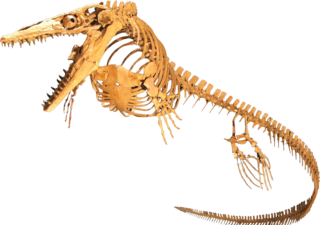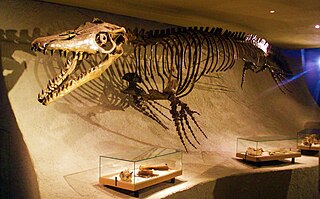
Mosasaurs comprise a group of extinct, large marine reptiles from the Late Cretaceous. Their first fossil remains were discovered in a limestone quarry at Maastricht on the Meuse in 1764. They belong to the order Squamata, which includes lizards and snakes.

Mosasaurus is the type genus of the mosasaurs, an extinct group of aquatic squamate reptiles. It lived from about 82 to 66 million years ago during the Campanian and Maastrichtian stages of the Late Cretaceous. The genus was one of the first Mesozoic marine reptiles known to science—the first fossils of Mosasaurus were found as skulls in a chalk quarry near the Dutch city of Maastricht in the late 18th century, and were initially thought to be the bones of crocodiles or whales. One skull discovered around 1780, which was seized by France during the French Revolutionary Wars for its scientific value, was famously nicknamed the "great animal of Maastricht". In 1808, naturalist Georges Cuvier concluded that it belonged to a giant marine lizard with similarities to monitor lizards but otherwise unlike any known living animal. This concept was revolutionary at the time and helped support the then-developing ideas of extinction. Cuvier did not designate a scientific name for the new animal, and this was done by William Daniel Conybeare in 1822 when he named it Mosasaurus in reference to its origin in fossil deposits near the Meuse River. The exact affinities of Mosasaurus as a squamate remain controversial, and scientists continue to debate whether its closest living relatives are monitor lizards or snakes.
Tylosaurus is a genus of mosasaur, a large, predatory marine reptile closely related to modern monitor lizards and to snakes, from the Late Cretaceous.
Goronyosaurus is an extinct genus of marine lizard belonging to the mosasaur family. Fossils of Goronyosaurus are exclusively known from the Dukamaje Formation of Niger and Nigeria and also the Rima Formation of Nigeria, and are both Maastrichtian in age. The holotype was first described in 1930 as Mosasaurus nigeriensis, but subsequent remains revealed a highly unique set of adaptations that prompted the species to be reclassified as the only species of the new genus Goronyosaurus in 1972. These unique adaptations have made Goronyosaurus notoriously difficult to classify within the Mosasauridae and it is often left out of phylogenetic analyses, although most authors agree that Goronyosaurus belonged to Mosasauridae.
Paleontology or palaeontology is the study of prehistoric life forms on Earth through the examination of plant and animal fossils. This includes the study of body fossils, tracks (ichnites), burrows, cast-off parts, fossilised feces (coprolites), palynomorphs and chemical residues. Because humans have encountered fossils for millennia, paleontology has a long history both before and after becoming formalized as a science. This article records significant discoveries and events related to paleontology that occurred or were published in the year 1931.

Liodon is a dubious genus of mosasaur from the Late Cretaceous, known from fragmentary fossils discovered in St James' Pit, England and possibly also the Ouled Abdoun Basin of Morocco. Though dubious and of uncertain phylogenetic affinities, Liodon was historically a highly important taxon in mosasaur systematics, being one of the genera on which the family Mosasauridae was based.
Amphekepubis is a dubious genus of mosasaur from the Late Cretaceous of Mexico. Their remains correspond to the holotype specimen UM VP 509, a partial skeleton preserved in three dimensions, comprising the pelvic area, hind limb bones and nine caudal vertebrae, found in the east of Monterrey, in the state of Nuevo Leon, which come from marine sediments (claystones) apparently from the San Felipe Formation, which corresponds to the boundary between the ages of Coniacian and Santonian in the early Late Cretaceous. Amphekepubis is classified within the Mosasaurinae subfamily of mosasaurs.

Angolasaurus is an extinct genus of mosasaur. Definite remains from this genus have been recovered from the Turonian and Coniacian of Angola, and possibly the Coniacian of the United States, the Turonian of Brazil, and the Maastrichtian of Niger. While at one point considered a species of Platecarpus, recent phylogenetic analyses have placed it between the (then) plioplatecarpines Ectenosaurus and Selmasaurus, maintaining a basal position within the plioplatecarpinae.

Anaschisma is an extinct genus of large temnospondyl amphibians. These animals were part of the family called Metoposauridae, which filled the crocodile-like predatory niches in the late Triassic. It had large skull about 62 centimetres (24 in) long, and possibly reached 3 metres (9.8 ft) long. It was an ambush hunter, snapping up anything small enough to fit in its huge jaws. It was very common during the Late Triassic in what is now the American Southwest.

Machaeroprosopus is an extinct genus of mystriosuchin leptosuchomorph phytosaur from the Late Triassic of the southwestern United States. M. validus, once thought to be the type species of Machaeroprosopus, was named in 1916 on the basis of three complete skulls from Chinle Formation, Arizona. The skulls have been lost since the 1950s, and a line drawing in the original 1916 description is the only visual record of the specimen. Another species, M. andersoni, was named in 1922 from New Mexico, and the species M. adamanensis, M. gregorii, M. lithodendrorum, M. tenuis, and M. zunii were named in 1930. Most species have been reassigned to the genera Smilosuchus, Rutiodon, or Phytosaurus. Until recently, M. validus was considered to be the only species that has not been reassigned. Thus, Machaeroprosopus was considered to be a nomen dubium or "doubtful name" because of the lack of diagnostic specimens that can support its distinction from other phytosaur genera. However, a taxonomic revision of Machaeroprosopus, conducted by Parker et al. in 2013, revealed that UW 3807, the holotype of M. validus, is not the holotype of Machaeroprosopus, while the species Machaeroprosopus buceros, Machaeroprosopus being a replacement name, with a fixed type species, for Metarhinus, is the combinatio nova of the type species of the genu: Belodon buceros. Therefore, the name Pseudopalatus must be considered a junior synonym of Machaeroprosopus, and all species of the former must be reassigned to the latter. This revised taxonomy was already accepted in several studies, including Stocker and Butler (2013). Stocker and Butler (2013) also treated M. andersoni as a valid species, and not a junior synonym of Machaeroprosopus buceros as was previously suggested by Long and Murry (1995).
The Severn Formation is a Mesozoic geologic formation in Maryland. Dinosaur remains diagnostic to the genus level are among the fossils that have been recovered from the formation.

This timeline of mosasaur research is a chronologically ordered list of important fossil discoveries, controversies of interpretation, and taxonomic revisions of mosasaurs, a group of giant marine lizards that lived during the Late Cretaceous Epoch. Although mosasaurs went extinct millions of years before humans evolved, humans have coexisted with mosasaur fossils for millennia. Before the development of paleontology as a formal science, these remains would have been interpreted through a mythological lens. Myths about warfare between serpentine water monsters and aerial thunderbirds told by the Native Americans of the modern western United States may have been influenced by observations of mosasaur fossils and their co-occurrence with creatures like Pteranodon and Hesperornis.
Doliognathus is an extinct genus of conodonts in the family Bactrognathidae from the Middle Dinantian. It is a genus of multielement conodonts.
Staurognathus is an extinct genus of conodonts in the family Bactrognathidae from the Middle Dinantian. It is a genus of multielement conodonts.
Edward B. Branson was an American geologist and paleontologist. He was a professor of geology at the University of Missouri.
Icriodus is an extinct conodont genus in the family Gnathodontidae.
Scaliognathus is an extinct genus of conodonts.

The Globidensini or Globidentatini are a tribe of mosasaurine mosasaurs, a diverse group of Late Cretaceous marine squamates. Members of the tribe, known as "globidensins" or "globidensine mosasaurs", have been recovered from North America, Europe, Africa and Asia. The tribe contains the genera Globidens, Carinodens, Igdamanosaurus, Harranasaurus and Xenodens. Features of the maxilla and digits make the placement of Carinodens and Xenodens in the tribe uncertain; some researchers have suggested that they may be more appropriately placed in the Mosasaurini.








